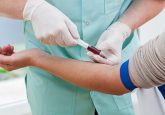Rapid detection of Ebola virus allowed by cellphone-sized device
The threat of future outbreaks of Ebola still remains, despite the worst of the recent epidemic being over. The speed with which tests to monitor the virus can be done is currently limited by laboratories requiring trained personnel. However, a handheld instrument that can rapidly detect Ebola has been reported by scientists in Analytical Chemistry – a study that highlights how the technology could be used in remote locations.
The identification of the Ebola virus in a blood sample presently involves packaging samples in cooled containers to be sent to specialized laboratories, which can be a long way from where the patients are based.
A method termed reverse-transcription polymerase chain reaction is then used by lab personnel to verify presence of the virus. Detection and treatment is delayed by this prolonged testing process, as is the real-time monitoring of viral loads in body fluid, which can harbor the virus even though it is no longer detectable in blood.
Pavel Neuzil and colleagues have previously reported the development of a cellphone-sized device enabling more accessible, reliable and fast Ebola detection.
This device was designed and tested by the researchers in the current study. It is capable of simultaneously performing four RT-PCRs, including two controls and two patient blood samples.
The new method produced test results in less than 37 minutes; a notable result compared with conventional tests, which vary from several hours to more than a day for the generation of results. Additionally, the new test requires very small quantities of blood, and could in the future come from just a finger prick.
Ebola RNA was successfully detected by the device. The test provided information about how many RNA copies each sample contained in addition to diagnosing the illness, which could potentially help healthcare workers to track viral load in the semen, breast milk and eye fluids of patients after recovery.
The next stage for researchers will involve application of the device in point-of-care diagnosis by forming an integrated sample-to-answer system.
Sources: Ahrberg C, Manz A, Neuzil P. Palm-sized device for point-of-care ebola detection. Anal. Chem. 88(9), 4803–4807 (2016); American Chemical Society press release via phys.org





